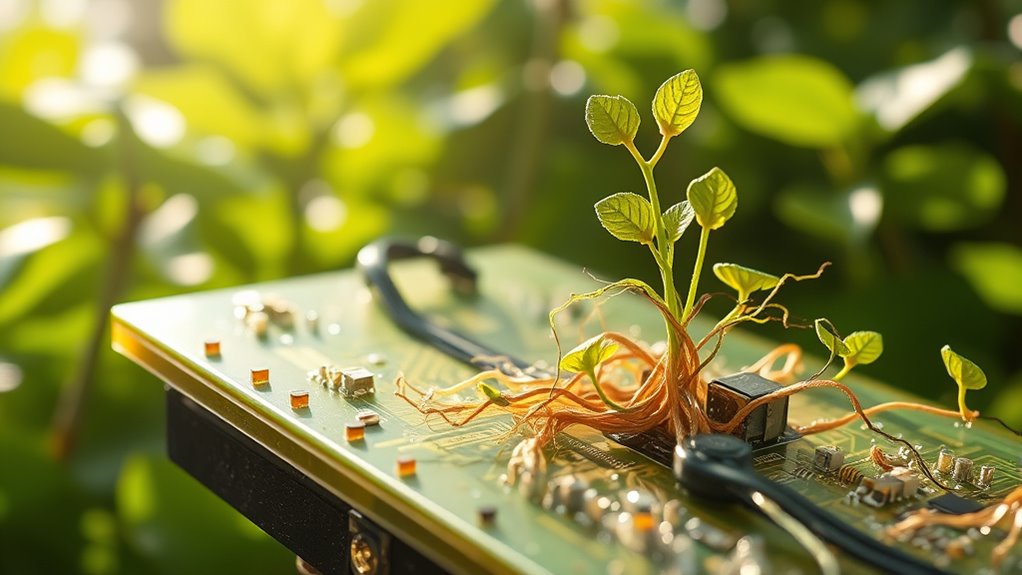Biodegradable electronics are transforming e-waste management by using eco-friendly materials that naturally decompose after disposal. These devices are made from biodegradable polymers, which break down through microbial enzymes into harmless substances, reducing environmental harm. Innovations like improved recycling processes and consumer awareness are boosting their adoption. While challenges remain, such as durability and cost, ongoing advances promise a future where electronic waste harms the planet less. To discover more about how this shift is happening, keep exploring the possibilities.
Key Takeaways
- Biodegradable electronics decompose naturally, reducing e-waste accumulation and environmental impact.
- Innovative biodegradable materials enable devices to break down safely after disposal.
- Improved recycling infrastructure and awareness promote responsible disposal of biodegradable gadgets.
- Advancements in eco-friendly components foster sustainable electronics manufacturing and consumption.
- Biodegradable electronics support a circular economy by minimizing waste and encouraging resource recovery.
The Rise of Eco-Friendly Materials in Electronics

As concerns about electronic waste grow, manufacturers are increasingly turning to eco-friendly materials to make their devices more sustainable. They’re embracing innovative options like biodegradable plastics and natural fibers, reducing reliance on harmful plastics and metals. Recycling initiatives play a key role here, encouraging consumers to properly dispose of electronics and support sustainable practices. Your awareness of the environmental impact influences these efforts; as more people demand greener products, companies respond by adopting eco-friendly materials. This shift not only minimizes waste but also promotes responsible consumption. By choosing devices made with biodegradable components, you help drive the industry toward more sustainable solutions. Understanding the importance of color accuracy and other technical features can also influence consumer choices that favor environmentally friendly options. The rising focus on eco-conscious manufacturing reflects a collective effort to reduce e-waste and protect the environment for future generations.
How Biodegradable Components Work

Have you ever wondered how biodegradable components break down safely in the environment? It all starts with biodegradable polymers, which are specially designed materials that can decompose naturally. These polymers are made from organic compounds that microorganisms, like bacteria and fungi, recognize and digest. Enzymatic degradation is the key process here, where enzymes break down the polymer chains into harmless byproducts such as water, carbon dioxide, and biomass. When electronic devices made with these materials are disposed of, microbes initiate this process, gradually transforming the components into eco-friendly substances. The degradation process can be controlled and optimized to ensure complete breakdown within a specific timeframe, making these materials highly effective for sustainable electronics. This natural breakdown prevents accumulation of e-waste in landfills and reduces environmental harm. By harnessing biodegradable polymers and enzymatic degradation, these components ensure that electronics can decompose safely without leaving toxic residues behind.
Innovations Transforming Electronic Waste Management

Innovations in electronic waste management are revolutionizing how we handle discarded devices and reduce environmental impact. New recycling infrastructure developments make it easier and more efficient to recover valuable materials from e-waste, minimizing landfill overflow. Advanced sorting technologies, like AI-powered systems, improve the separation process, ensuring more materials are recycled properly. These innovations also emphasize boosting consumer awareness, encouraging responsible disposal of electronics. Education campaigns inform people about proper recycling methods and the benefits of biodegradable electronics, fostering a culture of sustainability. By integrating better infrastructure with heightened awareness, we can considerably reduce e-waste and its harmful effects. The integration of Gold IRA investment principles can inspire more sustainable choices in electronic disposal and material recovery. These advancements empower you to participate actively in waste reduction efforts, ensuring that discarded devices are managed more sustainably and responsibly.
Challenges and Limitations of Biodegradable Devices

While biodegradable electronics offer promising environmental benefits, they still face significant challenges that hinder widespread adoption. One major hurdle is market adoption, which remains slow due to limited consumer awareness and high production costs. Additionally, durability concerns pose a significant obstacle; biodegradable devices often lack the longevity of traditional electronics, making them less suitable for applications requiring extended use. Manufacturers also struggle to balance biodegradability with performance, as materials that break down easily may not withstand daily wear and tear. Regulatory hurdles and the need for standardized testing further complicate progress. These factors combined restrict the rapid integration of biodegradable devices into mainstream markets, delaying the realization of their full environmental potential. Understanding consumer perceptions and overcoming these challenges is essential for their broader acceptance and impact.
The Future Impact of Sustainable Electronics

As sustainable electronics become more integrated into everyday life, their potential to substantially reduce environmental impact grows. Improved recycling infrastructure will be essential, enabling easier recovery of valuable materials and minimizing e-waste. You’ll see more efficient collection systems and innovative disposal methods that support eco-friendly practices. Consumer awareness also plays a critical role; as people understand the benefits of biodegradable and recyclable devices, they’ll make more responsible choices, encouraging manufacturers to prioritize sustainability. This shift can lead to a circular economy, where devices are designed for reuse and recycling, reducing waste. Additionally, advancements in biodegradable materials will further enhance the environmental benefits of future electronics. Over time, these efforts will foster a more sustainable electronics industry, helping to curb e-waste accumulation and lessen environmental harm, shaping a future where technology and ecology coexist harmoniously.
Frequently Asked Questions
Are Biodegradable Electronics as Durable as Traditional Gadgets?
You might wonder if biodegradable electronics are as durable as traditional gadgets. While they may not match the same material durability for long-term use, advancements are improving their resilience. These electronics often use eco-friendly materials that break down more easily, reducing environmental impact. So, although they might not last as long, their overall environmental benefits outweigh the durability differences, making them a smarter choice for sustainable tech use.
What Are the Cost Differences Between Biodegradable and Conventional Electronics?
Think of biodegradable electronics as a garden that grows with less watering. When you do a cost comparison, you’ll find that material expenses for biodegradable gadgets are often higher initially due to specialized, eco-friendly materials. However, over time, their lower disposal costs and environmental benefits can balance out or even save you money compared to conventional electronics, making them an increasingly attractive, sustainable choice.
Can Biodegradable Devices Be Repaired or Recycled After Use?
You might wonder if biodegradable devices can be repaired or recycled after use. Repair viability is limited because these devices are designed to break down naturally, making traditional repairs difficult. Recycling challenges also exist, as their materials are often complex or delicate. However, their eco-friendly nature reduces long-term waste. Overall, while repairs are usually not feasible, biodegradable electronics aim to minimize waste through natural decomposition rather than recycling or repair.
How Long Do Biodegradable Electronics Take to Decompose?
You might wonder about the decomposition timeline of biodegradable electronics. Typically, these devices break down within a few months to a year, depending on materials and environmental conditions. This quick decomposition considerably reduces environmental impact by preventing e-waste accumulation. By choosing biodegradable electronics, you help lower pollution and conserve resources, making a positive difference for the planet. Their timely decomposition ensures less harmful waste, supporting sustainable technology practices.
Are There Health Risks Associated With Biodegradable Electronic Materials?
You might wonder if biodegradable electronic materials pose health risks. Generally, they have low chemical toxicity because designers aim to minimize harmful substances. However, some materials could release toxins during degradation if not properly tested, affecting environmental impact and health. It’s vital to assess these factors carefully to guarantee biodegradable electronics are safe and truly eco-friendly, reducing potential risks to your health and the environment.
Conclusion
Imagine you’re planting seeds for a greener future, where electronics bloom and then gracefully return to the earth. By embracing biodegradable electronics, you help break the cycle of e-waste chaos, turning discarded devices into nutrients for the planet. While challenges remain, your choices today can shape a sustainable world tomorrow. Together, you’re cultivating a garden of innovation that promises a cleaner, healthier Earth—where technology and nature grow in harmony.










